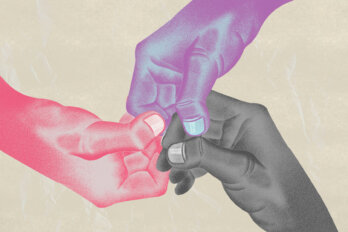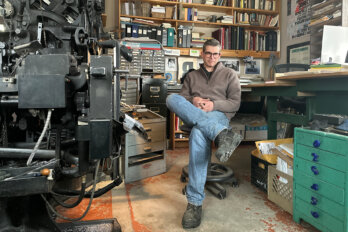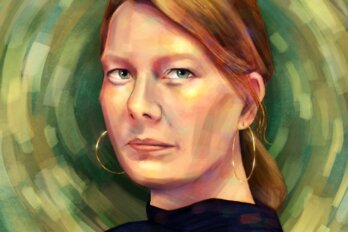I walked into the New Life Fertility Centre in Mississauga eight years ago feeling ashamed. What was wrong with me that I needed medical intervention to have a baby? Had I waited too long to start trying? Was I somehow sexually underdeveloped? Had I suppressed my maternal instincts—focusing too hard on a career?
Obviously, I had a number of preconceptions about infertile women. But the clients who awaited treatment at the clinic did not fit them. Yes, some of them were white and middle-class. Some were middle-aged. But I came to realize that women with fertility problems can be white, black, and brown; slim or curvaceous; young or old; they have no single personality type. I also came to appreciate that infertility is a medical condition rather than a character trait. This made it easier to talk about the experience with colleagues and friends. Some of them would say, as if surprised, “You can talk about this!” And I would answer, “I can, because it’s not my fault.”
In vitro fertilization, or IVF, first came into the public mind in the 1980s as something of a taboo subject. As new advances make it more widespread, and as women have become more willing to talk about their experiences, the subject has come to be represented increasingly in fiction and film—shaping a field of “infertility lit”. We have heard most about recent non-fiction publications, such as Belle Boggs’s memoir The Art of Waiting and Julia Lacey’s Avalanche. These accounts describe the hormonal toll of IVF on women’s bodies, and their struggles to accept themselves as valuable members of society. Yet stereotypes and callous treatment of the subject persist. I have been dismayed to encounter them recently in novels, and what makes it worse is that these were not poorly written books by unknown writers, but novels that I liked, novels of value, written by some of our most celebrated authors.
David Bergen has written nine novels and one story collection. His latest book Stranger, which came out last fall and was longlisted for the Scotiabank Giller Prize, opens with a fictional fertility clinic in Guatemala. The book, which is set in the near future, tells the story of Iso, a young Guatemalan woman who is robbed of her baby by Susan, an infertile American woman. Iso’s story is powerful and compelling, as she journeys to the United States to search for her lost daughter. But unfortunately, the story, which could be read as speculative fiction, nevertheless descends into stereotypes: Susan, who is white, blond, and skinny, has sex only for procreation. When she discovers she can’t conceive with her husband, Dr. Mann, she stops sleeping with him because, in her words, “What is the point?”
Iso, by contrast, is an earthy Latina. She loves Dr. Mann passionately, and gives herself to him with no fear of the consequences. She is also young and pure, whereas Susan is experienced and corrupt. Iso’s thoughts about Susan are ones of contempt: “She had learned that desperation in a woman’s face and body was not a pretty sight.” Susan is “like all the other women I’ve treated. She’s spoiled. She’s sad. She’s full of want. She’s greedy. She sees only herself.” She is a “skinny gringa.” The book unfolds as the war between a couple of women over a baby, and with the depiction of fertility itself.
“Iso felt appalled by Susan’s emptiness, her vanity, her ignorance,” Bergen writes. This contempt extends to all the women in the clinic: “Women who no longer loved themselves, but hoped to rekindle that love as they took the waters.” Eventually, Susan pays off the clinic’s director and tricks Iso into signing away her baby, an evil nurse snatching the child from its cradle at the hospital the night it is born.
Do infertile women go around stealing children? It can happen, but one seldom hears of it. One reason is that there are so many laws and regulations in place governing adoption, as well as surrogacy, and increasingly the donation of gametes and embryos. Try stealing some sperm or eggs, let alone a baby!
Stranger echoes some of the stereotypes of Margaret Atwood’s A Handmaid’s Tale, written in 1985, when IVF was in its infancy and infertility felt more like a permanent condition. Most of the discussion around the new TV series (which debuted two weeks ago on Bravo in Canada) has focused around the comparison with Trump’s America, and the totalitarian state—to my mind, some of the most chilling scenes are set around the depiction and privileging of fertile women over the women who can’t conceive. Again we have a young, nubile woman, Offred, who is fertile, pitted against an old, mean woman, Serena, who is infertile. (Read: Nice women do not suffer from infertility.) As in Stranger, the rich woman is called on to exploit the woman from an underprivileged class—a Handmaid. Atwood is more sensitive than Bergen to the constraints and oppression suffered by the infertile woman. At one point Offred reflects that she and Serena are equally miserable. Still, the author conflates sexuality and fertility; the fertile Handmaid is sexually attractive to both the patriarch, the Commander, and the driver, Nick. Serena is no longer sexually desirable. The Handmaid reflects on Serena: She is “withered” and “stale.”
In both Stranger and The Handmaid’s Tale, a woman’s happiness is contingent on the creation of a child. At one point Offred stares at some urinals, wondering why men have to compare each other’s genitals to prove to each other they are men. She reflects that women don’t have to prove their womanhood to each other in the same way. But the novel itself shows that having a baby is the female equivalent of comparing penis size.
Many prevailing stereotypes about motherhood are rooted in 1950s psychology. Historian Elaine Tailor May describes them in Barren in the Promised Land: Childless Americans and the Pursuit of Happiness, a path-breaking study of the history of infertility. After the Second World War, many women were treated for infertility by psychologists. Psychologists counselled physicians to treat women for infertility only if they were “fit” to become mothers. A physician’s first task, then, was to determine a woman’s fitness for the job. To this end, he should ask several questions: “Is the patient a cold, selfish, demanding person, or is she a warm, giving woman?” Unsuitable were “the aggressive and masculine women who are competitive, strong, ambitious, and dominating. They ‘wear the pants in the family’ and are usually successful career women, possessing considerable executive ability.”
The consequences of treating an unsuitable woman and allowing her to conceive could be dire, as her future child could be psychologically damaged. Connected to this idea is the corollary that an infertile woman could become fertile if she changed her behaviour and character. If a career woman gave up working to stay at home, a latent motherliness would develop and her body would soften, allowing her to conceive. Frigidity was closely associated with infertility. Similarly, adoption could be a cure for infertility, a way of developing a woman’s maternal instinct—allowing her to feel happy and relaxed, and thus able to bear her own child. Infertile women subconsciously did not want children and resented maternal responsibility.
The 1970s saw the rise of a new child-free movement, followed by a wider return to pro-natalism in the 80s. IVF treatments have only become more prevalent since. I do think there has been an evolution in the way we think about it, especially as more and more women discuss their experiences anecdotally. Infertility is also more normalized from a medical perspective—the Ontario government’s recent decision to fund one cycle of IVF for couples echoes an existing program in Quebec, although in both places there are complications. Funding is allocated only to some clinics, creating huge waiting lists and necessitating that doctors prioritize more “eligible” couples and women based on health and age. Thus, we create further stereotypes about what makes someone a fit mother.
At heart, infertility is rooted in the mechanics of the body itself. An estimated 16 percent of heterosexual couples experiences it for a complex network of possible reasons, from blocked fallopian tubes to endometriosis to poor egg quality. Yet the common advice to “relax and get pregnant” still implies that the failure to conceive lies in a woman’s character; that she is too uptight, too active, too self-interested. It is unfortunate that these prejudices also persist in fictional representations of infertility.
A more sympathetic representation of infertility can be found in Karma Brown’s 2016 mass-market novel, The Choices We Make. The story presents Kate, a mother of two girls, and Hannah, infertile but desperate to have a child. Kate decides to act as a surrogate for Hannah. In the tradition of the Harlequin romance, there is a degree of drama that stretches credulity in this book, and way too many tears are shed. But I loved the portrayal of Hannah: there is no nonsense about wealth, whiteness, or frigidity. She is just a regular person, no different from her friend, but afflicted with infertility, for reasons that are arbitrary and biological.
Why should a mass-market book be better able to address the issue than literary fiction—the stuff to which we give big awards? A possible reason is that there is far less concern with archetypes and symbolism, so infertility doesn’t have to have a meaning in itself, as it does in Atwood and Bergen. The very things that we value in literary fiction may be the things that can lead to unwelcome stereotypes. Another important distinction is that Karma Brown, a journalist, herself experienced infertility, and much of the story is told from the point of view of the character struggling with the condition. It’s not metaphor; it’s human life. As more women speak about their experiences, perhaps popular perception as well as imaginative representations will come to view infertility as a medical problem, and as multidimensional, human, and complex.
I first started trying to have children when I was thirty-five, at the first point in my life where I had a willing partner and a stable job. I had recently completed my PhD and had a tenure-track job. It seemed reasonable to start trying when we did. But even as I explained this to a friend, she said, “You started trying too late.” Perhaps she was right. On the other hand, perhaps I would have had fertility problems even in my twenties. I received further input and suggestions such as “relax and you will get pregnant.” No doubt all women trying to have a baby will hear this. Eventually, my partner and I ended up having three children through assisted reproduction. Our three daughters are the centre of my life and have brought me great joy. I think most mothers would say the same of their families. But I have never taken motherhood for granted. My own experience has taught me that we need to be more careful about how we define motherhood, and the myths we create around it. The work of raising a child is an entirely different thing than giving birth to one—work that is done not just by parents, but by grandparents, aunts and uncles, nannies and babysitters, daycare workers and teachers. The irony is that, after struggling so hard to become a mother, I find myself thinking of the contribution of these other caregivers every single day.





